Bureau Veritas Bundle
How Does Bureau Veritas Navigate the TIC Industry's Competitive Waters?
The Testing, Inspection, and Certification (TIC) sector is a dynamic arena where quality and compliance reign supreme. Bureau Veritas, a global leader with a rich history dating back to 1828, has consistently adapted to meet evolving industry demands. Understanding its position within this complex Bureau Veritas SWOT Analysis is crucial for anyone seeking to navigate the global market.
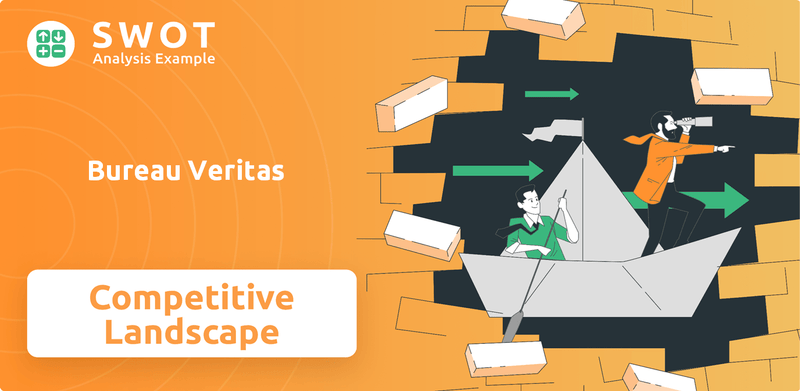
This Company Analysis will dissect Bureau Veritas's Competitive Landscape, exploring its market share, identifying key competitors, and examining its strategic advantages. We will delve into the latest Industry Trends, including sustainability and technological advancements, to understand how Bureau Veritas is positioned for future growth. This comprehensive analysis will provide valuable insights into Bureau Veritas's financial performance and its ability to thrive in a competitive global environment, answering questions like: Who are Bureau Veritas' main competitors? and How does Bureau Veritas compare to its rivals?
Where Does Bureau Veritas’ Stand in the Current Market?
Bureau Veritas holds a prominent position within the global Testing, Inspection, and Certification (TIC) industry. The company's diverse service offerings and extensive global presence contribute to its strong market standing. The company's financial performance, including revenue growth and strategic initiatives, highlights its robust position in the competitive landscape.
The company's core operations involve providing a wide range of services across various sectors, including Buildings & Infrastructure, Agri-Food & Commodities, and Industry. These services are essential for ensuring compliance, safety, and quality standards. Bureau Veritas' value proposition lies in its ability to offer comprehensive solutions that support clients in meeting regulatory requirements and improving operational efficiency.
In Q1 2025, Bureau Veritas reported revenue of €1.6 billion, marking an 8.3% increase year-on-year, with organic growth of 7.3%. For the full year 2024, revenue reached €6.24 billion, a 6.4% increase from 2023, with organic growth of 10.2%. These figures reflect the company's strong financial health and ability to grow in the market.
Bureau Veritas operates across several key sectors. Buildings & Infrastructure accounted for 27% of 2022 revenue, Agri-Food & Commodities for 23%, and Industry for 22%. The company's Marine & Offshore and Certification divisions also contribute significantly. The Industry, Marine & Offshore, and Certification divisions showed particularly strong organic growth in Q1 2025.
Bureau Veritas has a vast global presence, operating in 140 countries through over 1,500 offices and laboratories. The Americas accounted for 26% of Q1 2025 revenue, Europe for 35%, Asia-Pacific for 28%, and Africa and the Middle East for 11%. This extensive network allows the company to serve clients worldwide.
The company focuses on digital transformation, investing in AI and IoT to enhance service delivery. Bolt-on acquisitions are a key part of its strategy, such as the acquisition of ANCE in Mexico in 2024. These initiatives are part of Bureau Veritas' growth strategy to strengthen its market position and expand into new segments.
The competitive landscape for Bureau Veritas includes several key players in the TIC industry. Understanding the competitive dynamics is crucial for assessing the company’s market position and future prospects. For more insights, read the Brief History of Bureau Veritas.
Bureau Veritas' key performance indicators (KPIs) include revenue growth, organic growth, and market share. The company's financial health is rated as 'FAIR' by InvestingPro analysis, and Moody's assigned an A3 credit rating with a stable outlook in 2024. These metrics reflect the company's strong financial structure.
- Revenue of €1.6 billion in Q1 2025.
- Organic growth of 7.3% in Q1 2025.
- Revenue of €6.24 billion for the full year 2024.
- A3 credit rating with a stable outlook from Moody's.
Bureau Veritas SWOT Analysis
- Complete SWOT Breakdown
- Fully Customizable
- Editable in Excel & Word
- Professional Formatting
- Investor-Ready Format
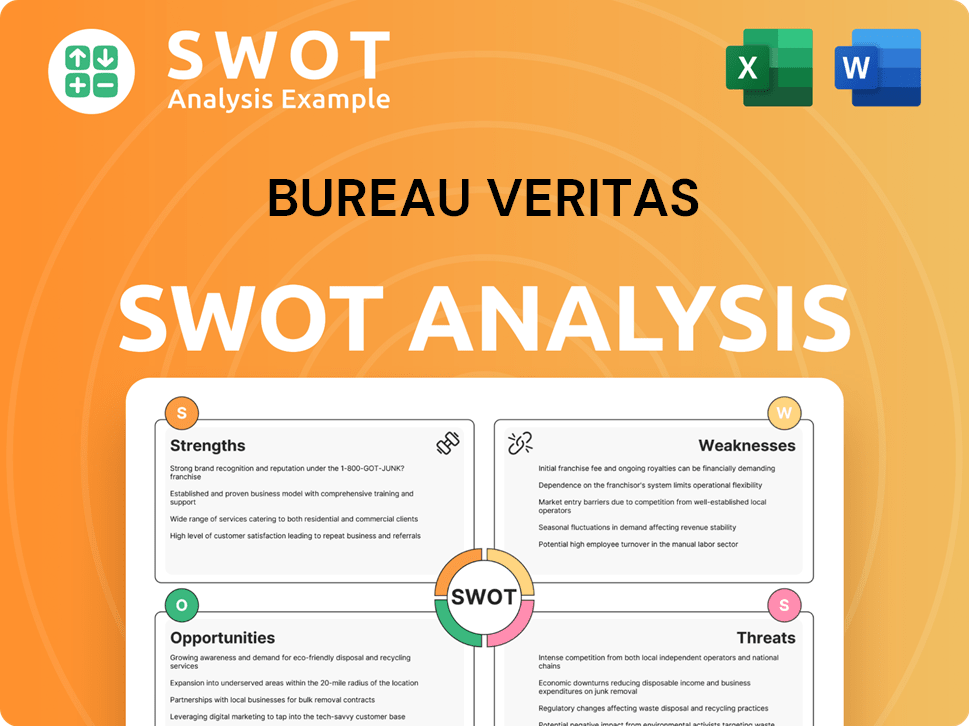
Who Are the Main Competitors Challenging Bureau Veritas?
The Target Market of Bureau Veritas is significantly shaped by the competitive landscape within the Testing, Inspection, and Certification (TIC) industry. Understanding the key players and their strategies is crucial for analyzing Bureau Veritas's market position and growth potential. This analysis provides insights into how Bureau Veritas competes and adapts in a dynamic market environment.
Bureau Veritas faces a competitive environment, which includes both direct and indirect rivals. These competitors challenge Bureau Veritas through various means, including price competition, innovation, and strategic acquisitions. The TIC sector is dynamic, with emerging players and evolving industry trends influencing the competitive dynamics.
The competitive landscape for Bureau Veritas features strong direct and indirect competitors. These companies offer similar services and compete for market share across various industries. Understanding these rivals is essential for a thorough company analysis.
Bureau Veritas's main direct competitors include Intertek, SGS, LRQA (Lloyd's Register Quality Assurance), Applus+, and Kiwa. These companies provide similar TIC services, often competing on a global scale and service breadth. They pose direct challenges across various sectors.
Indirect competitors include UL Solutions, DNV, and the American Bureau of Shipping. These companies specialize in specific areas, such as risk management or maritime services. They compete with Bureau Veritas in particular niches.
SGS, a Swiss multinational, is a major direct competitor, offering extensive laboratory testing, inspection, and certification services. SGS competes with Bureau Veritas on service breadth and global reach. Both companies serve a wide array of industries.
Intertek, based in the UK, provides total quality assurance (TQA) solutions. It competes by offering end-to-end services across various sectors. Intertek's comprehensive service offerings make it a key competitor.
DNV specializes in risk management and assurance, particularly in maritime, oil and gas, and renewables. DNV poses a direct challenge in these specific industries. The company's expertise in these sectors makes it a significant competitor.
Competitors challenge Bureau Veritas through price competition, innovation, and strategic initiatives. These strategies aim to differentiate services and capture specific customer segments. The TIC sector is also influenced by emerging players and industry consolidation.
- Price Competition: A constant factor, especially in commoditized TIC services.
- Innovation: Companies invest in new technologies like AI and IoT. Bureau Veritas acquired Aligned Incentives to enhance its sustainability analysis capabilities.
- Branding and Distribution: Competitors use branding, distribution networks, and technological advancements to differentiate themselves.
- Strategic Acquisitions: Bureau Veritas's acquisitions in consumer electronics testing in Asia and infrastructure services in Australia in 2024 show a proactive approach.
- Emerging Players: Companies focused on sustainability compliance and digital solutions are disrupting the landscape. Crosscheck provides sustainability compliance in renewable energy.
- Mergers and Alliances: These can impact competitive dynamics by consolidating market power.
Bureau Veritas PESTLE Analysis
- Covers All 6 PESTLE Categories
- No Research Needed – Save Hours of Work
- Built by Experts, Trusted by Consultants
- Instant Download, Ready to Use
- 100% Editable, Fully Customizable
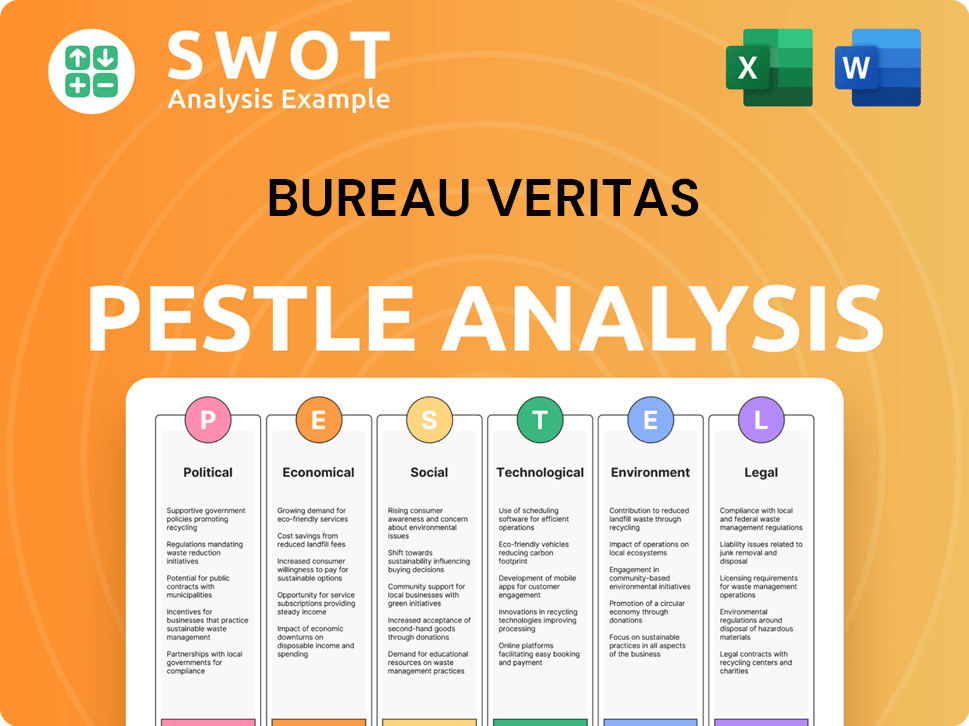
What Gives Bureau Veritas a Competitive Edge Over Its Rivals?
Understanding the competitive landscape of Bureau Veritas requires a deep dive into its core strengths and how it differentiates itself from rivals. The company's enduring success stems from a combination of factors, including its established brand reputation, extensive global reach, and continuous innovation in service offerings. These elements collectively fortify its market position and enable it to maintain a competitive edge in the Testing, Inspection, and Certification (TIC) industry.
Bureau Veritas has built a strong foundation over nearly two centuries, establishing itself as a trusted name in the TIC market. This long-standing presence has allowed the company to cultivate a global network and build strong relationships with clients across various sectors. The ability to adapt to evolving industry demands and regulatory changes further supports its competitive standing.
The company's strategic initiatives, particularly its focus on digital transformation and sustainability, are crucial for future growth. Recent acquisitions and investments in technology, such as the acquisition of Aligned Incentives in late 2024, highlight its commitment to enhancing its service offerings and staying ahead of industry trends. These moves are essential for maintaining its competitive advantage and meeting the evolving needs of its clients.
Bureau Veritas benefits from a strong brand reputation built over almost 200 years. This long-standing presence has fostered trust and recognition within the TIC market. The company's reputation for high quality and impartiality is a key differentiator, crucial for securing and retaining clients.
With operations spanning 140 countries and over 1,500 offices and laboratories, Bureau Veritas boasts a vast global presence. This extensive network enables the company to offer a broad range of services and effectively serve multinational clients. This global reach is a significant advantage over smaller, regional competitors.
Bureau Veritas actively integrates advanced technologies, such as AI and IoT, to enhance service delivery. The acquisition of Aligned Incentives in late 2024 demonstrates its commitment to leveraging AI for sustainability and emissions analysis. This focus on innovation improves customer experience and service quality.
The company maintains a high customer retention rate, exceeding 90% across its businesses. This loyalty stems from the essential nature of TIC services and the high switching costs for clients. A diversified revenue base across sectors like Industry, Marine & Offshore, and Certification also contributes to stability.
Bureau Veritas's competitive advantages are multifaceted, encompassing brand reputation, global reach, technological innovation, and customer loyalty. These strengths are reinforced by a skilled workforce of 84,000 employees and a culture emphasizing ethical standards. The LEAP | 28 strategy focuses on developing strategic competencies in sustainability, energy transition, and digital, further enhancing its competitive edge.
- Strong Brand and Reputation: Nearly 200 years of history, building trust and recognition.
- Extensive Global Network: Operations in 140 countries, allowing for broad service offerings.
- Technological Innovation: Integration of AI and IoT to improve service delivery.
- High Customer Retention: Retention rate exceeding 90%, reflecting essential services.
Bureau Veritas Business Model Canvas
- Complete 9-Block Business Model Canvas
- Effortlessly Communicate Your Business Strategy
- Investor-Ready BMC Format
- 100% Editable and Customizable
- Clear and Structured Layout
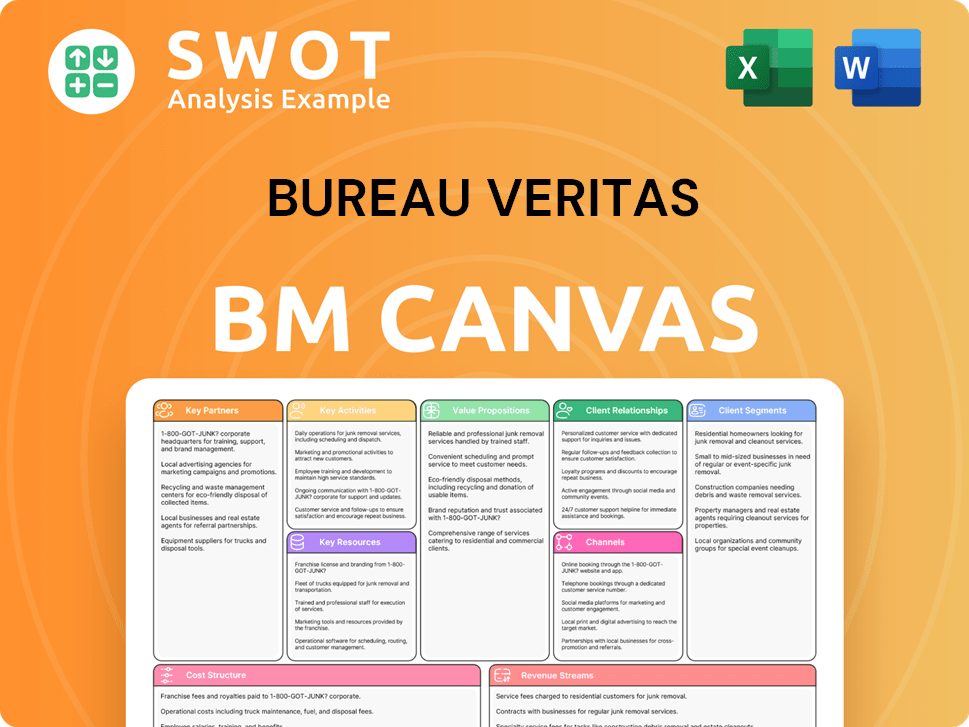
What Industry Trends Are Reshaping Bureau Veritas’s Competitive Landscape?
Understanding the current and future position of Bureau Veritas requires a close look at the evolving competitive landscape. The company faces challenges and opportunities influenced by technological advancements, regulatory changes, and global economic shifts. A deep company analysis reveals strategic moves and the company's adaptation to an ever-changing market.
The Bureau Veritas is currently navigating a dynamic environment, with a focus on sustainability and digital transformation. This article aims to provide insights into the industry trends, potential challenges, and growth opportunities. The analysis considers the company's strategic positioning, financial performance, and its response to market dynamics.
The Testing, Inspection, and Certification (TIC) industry is undergoing significant changes driven by technological advancements, particularly in digitalization, AI, and IoT. Regulatory changes, especially in sustainability and environmental protection, are creating substantial demand for TIC services. Global economic shifts and geopolitical tensions can influence supply chains and affect revenue, as acknowledged by Bureau Veritas.
Potential threats include aggressive new competitors, especially niche players focused on specific technologies or sustainability solutions. There is a risk of declining demand in certain sectors and increased regulation that might impact operational models. Navigating complex and varying global regulations remains a continuous challenge for Bureau Veritas.
Significant growth opportunities exist in emerging markets, particularly in Africa and Asia-Pacific, where demand for TIC services is surging. Product innovations, such as new tools for asset integrity management, also represent avenues for growth. Strategic partnerships are crucial for leveraging external expertise and expanding offerings.
Bureau Veritas is focused on digital transformation to increase efficiency and create value. The company's LEAP | 28 strategy places sustainability at its core, aiming to accelerate the transition towards a decarbonized economy. The recent acquisition of Aligned Incentives exemplifies the focus on sustainability and Scope 3 emissions analysis. For more details, review the Marketing Strategy of Bureau Veritas.
Looking ahead to 2025, Bureau Veritas anticipates mid-to-high single-digit organic revenue growth, an improvement in adjusted operating margin, and strong cash flow with a cash conversion above 90%. The company's strategy involves active portfolio management, disciplined acquisitions, and divesting non-core assets.
- Active portfolio management, including disciplined bolt-on acquisitions to expand leadership.
- Divesting non-core assets like its Food testing business.
- Accelerating performance programs and maintaining close customer proximity.
- Developing new opportunities and strategic partnerships.
Bureau Veritas Porter's Five Forces Analysis
- Covers All 5 Competitive Forces in Detail
- Structured for Consultants, Students, and Founders
- 100% Editable in Microsoft Word & Excel
- Instant Digital Download – Use Immediately
- Compatible with Mac & PC – Fully Unlocked
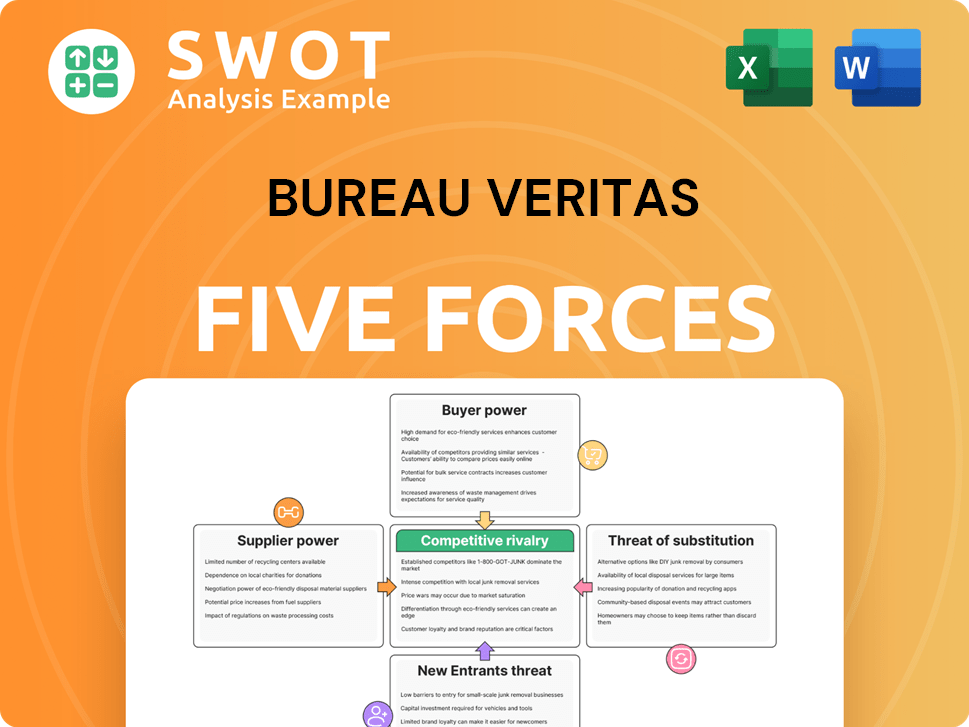
Related Blogs
- What are Mission Vision & Core Values of Bureau Veritas Company?
- What is Growth Strategy and Future Prospects of Bureau Veritas Company?
- How Does Bureau Veritas Company Work?
- What is Sales and Marketing Strategy of Bureau Veritas Company?
- What is Brief History of Bureau Veritas Company?
- Who Owns Bureau Veritas Company?
- What is Customer Demographics and Target Market of Bureau Veritas Company?
Disclaimer
All information, articles, and product details provided on this website are for general informational and educational purposes only. We do not claim any ownership over, nor do we intend to infringe upon, any trademarks, copyrights, logos, brand names, or other intellectual property mentioned or depicted on this site. Such intellectual property remains the property of its respective owners, and any references here are made solely for identification or informational purposes, without implying any affiliation, endorsement, or partnership.
We make no representations or warranties, express or implied, regarding the accuracy, completeness, or suitability of any content or products presented. Nothing on this website should be construed as legal, tax, investment, financial, medical, or other professional advice. In addition, no part of this site—including articles or product references—constitutes a solicitation, recommendation, endorsement, advertisement, or offer to buy or sell any securities, franchises, or other financial instruments, particularly in jurisdictions where such activity would be unlawful.
All content is of a general nature and may not address the specific circumstances of any individual or entity. It is not a substitute for professional advice or services. Any actions you take based on the information provided here are strictly at your own risk. You accept full responsibility for any decisions or outcomes arising from your use of this website and agree to release us from any liability in connection with your use of, or reliance upon, the content or products found herein.